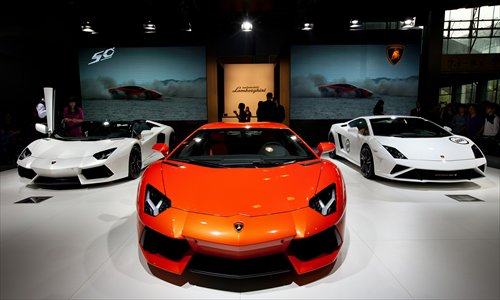Gray imports

Lamborghini Aventados displayed at Auto Guangzhou on Novembmer 23, 2013 Photo: CFP
In 2013, about 22 million vehicles were sold in China, the world's largest auto market for five consecutive years, according to data released on January 9 by the China Association of Automobile Manufacturers.
Although, starting from 2013, luxury car sales have been influenced by Chinese authorities advocating more frugality, China is still a promising market for premium carmakers.
Rolls-Royce, the British luxury car acquired by the BMW Group, saw 11 percent year-on-year sales growth in 2013 in the Chinese mainland, which accounted for 40 percent of its global sales, according to auto news portal gasgoo.com.
China has become the largest market for the BMW Group, which sold 390,713 BMW and Mini brand vehicles on the Chinese mainland in 2013, an increase of 19.7 percent over the previous year, according to the BMW Group's website.
However, it is much more expensive to buy a car, especially luxury cars in China than in overseas markets such as the US due to import taxes and dealerships' different pricing strategies.
Luxury car price gap
In China a Cayenne S Hybrid is priced at 1.438 million yuan ($236,316) with VAT included, while according to Porsche's website the manufacturer's suggested retail price in the US is only $70,900.
A BMW X535i is priced at 901,000 yuan in China, whereas the price in the US comes to only 630,000 yuan, the 21st Century Business Herald reported Monday.
Importers have to pay several different taxes for vehicles imported to China, including a 25 percent tariff, a consumption tax based on engine displacement, a 17 percent value-added tax and an approximate 10 percent purchase tax.
In addition to these taxes, high dealership profits further increase the price of imported cars in China.
An SUV with 3.0 liter engine displacement, which is priced at $60,900 in the US, should cost nearly 780,000 yuan after all taxes in China are paid. However, prices set by dealerships in the Chinese market run as high as 1.24 million yuan, The Chongqing Morning Post newspaper reported in August 2013, noting the profit rate for luxury cars in China is close to 37 percent, significantly higher than the 20 percent industry standard.
Purchasing cars from overseas
The price gap between China and the US has created a shady sub-sector dedicated to purchasing cars from overseas.
Dai, an auto dealer who only provided his surname, told the Global Times Monday that some dealers, including him, help customers purchase cars imported by trading companies located in port cities such as North China's Tianjin.
"These trading companies import overseas cars, usually from the US, and we cooperate with these companies to sell them," Dai said.
These trading companies have an import license, which is required for importing vehicles from overseas to China, he said.
The trading companies pay taxes including tariff and are also responsible for acquiring China Compulsory Certification (3C) for the cars, according to Dai.
All vehicles must acquire 3C before being sold or driven in China.
An insider who is close to the business in Tianjin, told the Global Times Monday on condition of anonymity that these trading companies buy quotas for importing US second-hand vehicles from US citizens who work in China.
Each US citizen who works in China can legally import a second-hand car from the US. However, not everyone does that. Therefore, these trading companies buy the quota from them, he said, refusing to reveal the price of a quota.
With these quotas, the Chinese trading companies can then import second-hand cars, only needing to ensure these vehicles meet 3C requirements in China. They can then be sold for profit, the insider said, noting the trading companies can earn at least 100,000 yuan for each car.
The price of these imported cars can be 10 percent lower than the official price in the Chinese market because dealership profit is less than that of 4S shops, Dai said.
Buyers of these imported cars also face some risk, mainly when it comes to repairs, Wang Cun, a marketing manager at China Automobile Trading Company, told the Global Times Tuesday.
It is time-consuming and expensive to change or repair parts in imported cars, while cars imported by private trading companies may not enjoy the same maintenance services that the 4S shops provide for officially imported cars, he said.
Gray market
The overseas purchasing of luxury cars has given businessmen in the US, such as Michael A. Downs, an opportunity to take advantage of the price gap that exists between the two markets, The New York Times reported on February 11.
He ran his business for three years by hiring people to buy new cars from dealers in the US and selling these cars to other firms, which then ship them to China, the report detailed.
There are about 35,000 new luxury cars shipped to China from the US in this way each year, the report said.
The US authorities began banning this "gray market" auto export business for deceptive practices as most carmakers demand dealers verify that no cars are bought for immediate export.
Some lawsuits with the purpose of stopping the resale of luxury cars to China have been filed in several states in the US, and hundreds of cars in businesses have been seized, the report said.
Downs has filed a lawsuit hoping to accelerate the decision to determine whether his business is legal or not. This lawsuit is still pending, According to the report.